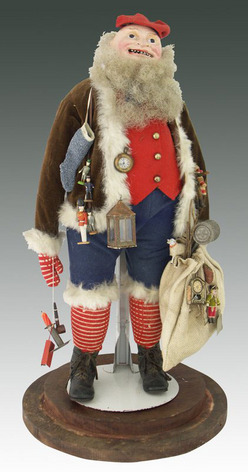 As small children, most of us were likely threatened with lumps of coal or switches in our stockings, but for the most part, modern-day Christmas celebrations focus far more on the nice than on the naughty. This wasn’t always the case, and our jovial 20th-century Saint Nick and his comical elfin sidekicks have their roots in a much darker image: the ancient Germanic Christmas figure of Pelzsnickel, literally “furry Nicholas.” The character of Pelznickel, known throughout Europe, followed the Germans across the Atlantic to Pennsylvania where he became Belsnickel or Belsnickle. Crossing cultural lines, Pelznickel morphed into a variety of characters ranging from a dark, frightening whip-carrying figure in ghoulish costume to a gentle fur-clad woodsman dispensing toys and justice. Somewhere along the line, however, he became “our” Santa and “belsnickle” became the word for a traditional Santa ornament.
As small children, most of us were likely threatened with lumps of coal or switches in our stockings, but for the most part, modern-day Christmas celebrations focus far more on the nice than on the naughty. This wasn’t always the case, and our jovial 20th-century Saint Nick and his comical elfin sidekicks have their roots in a much darker image: the ancient Germanic Christmas figure of Pelzsnickel, literally “furry Nicholas.” The character of Pelznickel, known throughout Europe, followed the Germans across the Atlantic to Pennsylvania where he became Belsnickel or Belsnickle. Crossing cultural lines, Pelznickel morphed into a variety of characters ranging from a dark, frightening whip-carrying figure in ghoulish costume to a gentle fur-clad woodsman dispensing toys and justice. Somewhere along the line, however, he became “our” Santa and “belsnickle” became the word for a traditional Santa ornament.
Belsnickles, for the most part, are surprisingly uniform. Aside from the colorful character pictured here, who is saddled with toys and the accoutrements one might need when tramping through the woods on a snowy evening and whose uniqueness is reflected in his $25,000 price, most belsnickles take the standard form of a somber, robed Saint Nick. Occasionally, he is holding a small Christmas tree, but otherwise, the only thing that varies is the color of his robe. Not to worry, though, because his robe comes in a rainbow of colors from the traditional red or white to orange, yellow, blue, and even pink! Value is, as always, determined by condition but also by the rarity of the color of Santa’s robes. Nice or naughty, any Christmas collector can appreciate these colorful characters!



